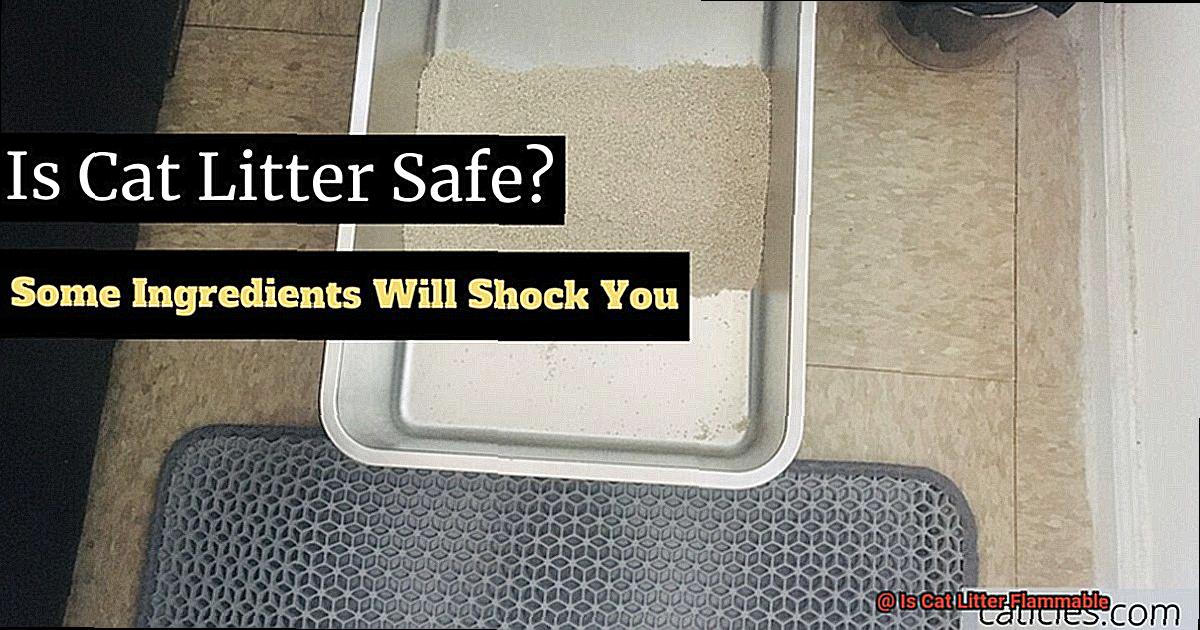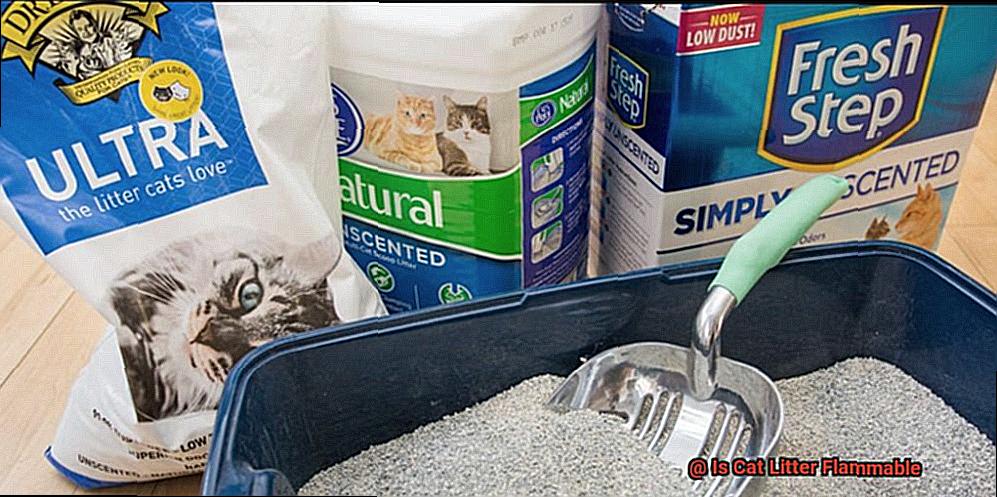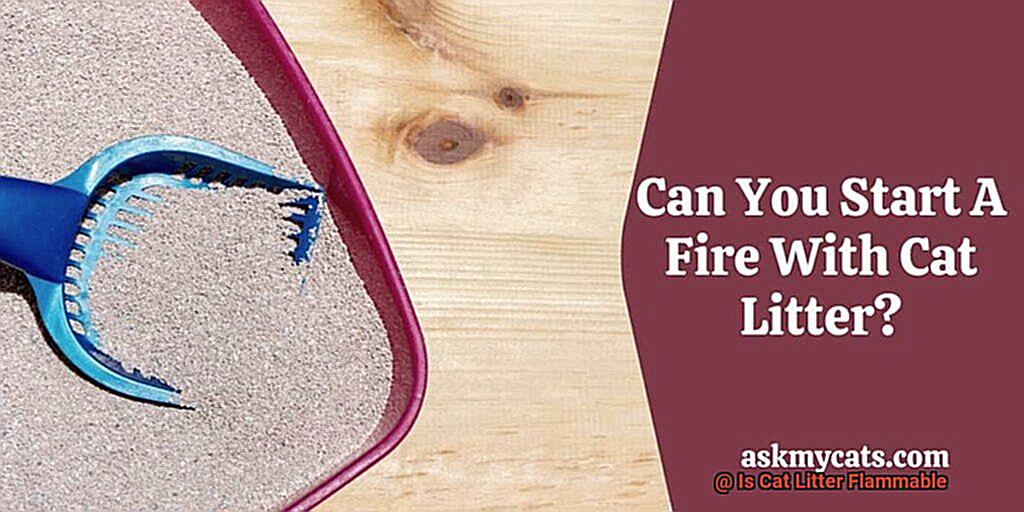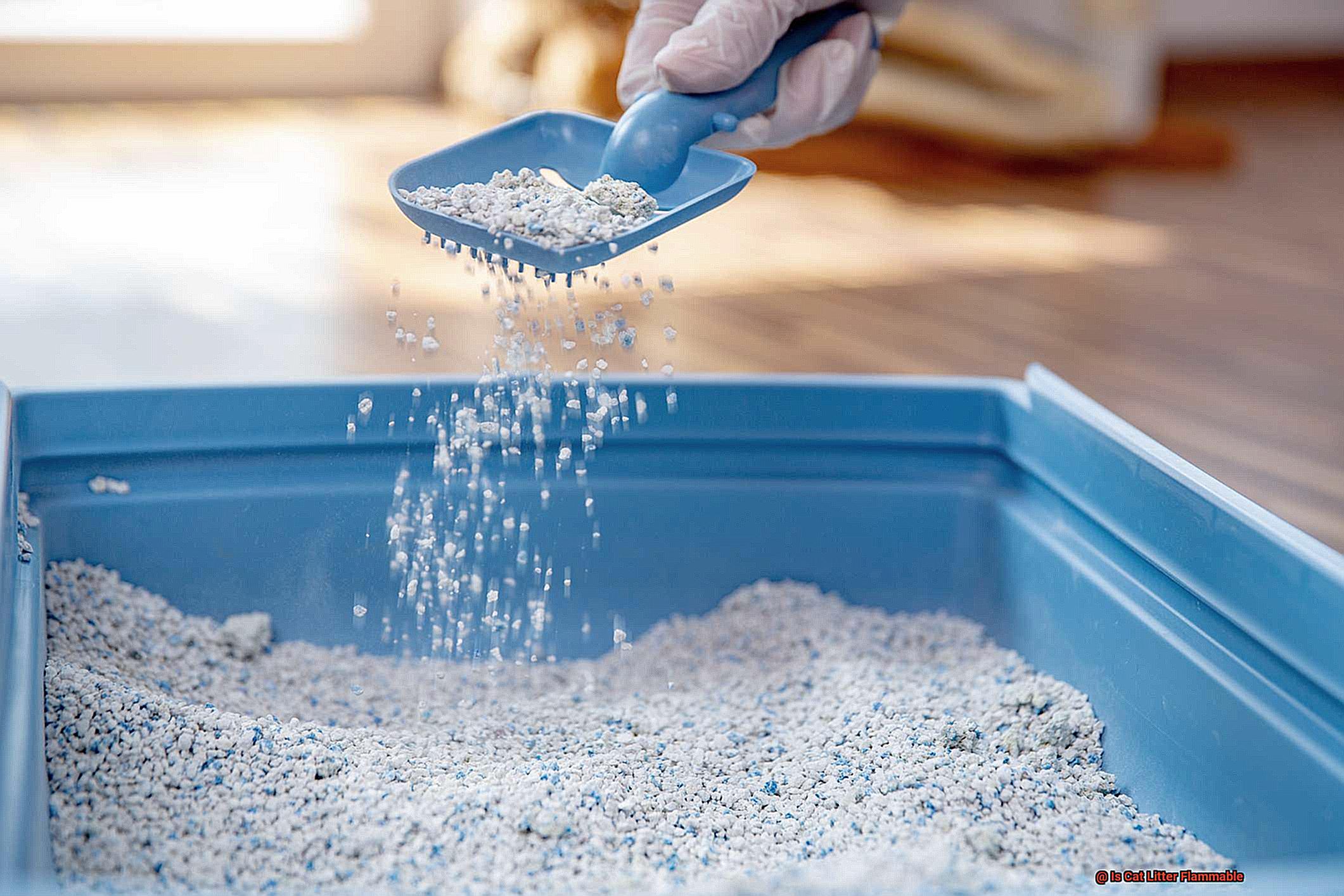Is cat litter flammable? It’s a good question to ask when considering where to keep your cat’s box. After all, you don’t want to risk a home fire due to a poorly placed litter box.
The answer is both yes and no. Clay-based litters are generally more flammable than natural litters such as paper or wood pellets. This is because clay-based litters contain combustible materials like sodium bentonite clay and silica powder. Natural litters, however, are non-combustible.

To protect your pet and home from potential fires, it’s important to know which types of litter are more flammable and how to store them away from heat sources. Avoid placing the litter box near stoves or radiators, and never use an open fire near the garbage can. If you live in an area prone to wildfires, it’s also recommended that you keep your cat indoors during these times.
By taking these steps and knowing which varieties of litter are more harmful than others, you can ensure that your cat has a safe place to go while still shielding your house from potential fires.
What is Cat Litter Made of?
Cats can be picky when it comes to their litter box, but have you ever stopped to wonder what cat litter is made of? It turns out that there are only a few materials commonly used for this purpose.
Clay is the most popular option due to its ability to absorb moisture and form clumps when wet. Silica gel is another option, albeit more expensive, as it absorbs moisture well and produces less dust. Plant-based materials such as wood chips, corn cobs, and wheat are also available, making them the more eco-friendly choice.
What Happens When You Burn Cat Litter?
Burning cat litter can be a deadly mistake! When you burn cat litter, it releases toxic fumes and smoke that can be dangerous to humans and animals alike.
Therefore, it’s essential to take precautionary measures when burning cat litter. Additionally, if the heat source is too strong or the litter is left unattended, a fire could easily start.
Furthermore, burning cat litter releases carbon monoxide, an odorless and deadly gas, into the air. Finally, burning cat litter also produces ash that can be hard to clean up.
Is Cat Litter Flammable?
Cat litter is a common household item for cat owners, but many people don’t know if it’s flammable.
The answer is yes and no. Certain types of cat litter can be flammable, while others are not.

Clay-based litters are the most common type of litter used by cat owners, and these are generally not flammable.

However, some clay-based litters contain additives such as sodium bentonite, which can be flammable.
If your cat litter contains sodium bentonite, it’s best to keep it away from any open flames or heat sources.
On the other hand, there are non-clay-based litters that can be flammable. These include wood-based litters, such as those made from pine or cedar shavings.

These litters are highly flammable and should be kept away from any open flames or heat sources.
It’s also important to make sure that your cat’s litter box is in a well-ventilated area, as this will help reduce the risk of a fire.
In conclusion, it’s important to know whether your cat litter is flammable or not. Clay-based litters are generally not flammable, but some may contain additives that can be flammable.
Wood-based litters are highly flammable and should be kept away from any open flames or heat sources.

It’s also important to make sure that your cat’s litter box is in a well-ventilated area for safety reasons.
Can Cat Litter be Used in Arson?
Fire is a dangerous and destructive force. But did you know that something as simple as cat litter can be used to start one? That’s right—cat litter is flammable and ignites quickly, making it a popular choice for arsonists.
It has been linked to some of the most infamous crimes in recent history, including the 1995 Oklahoma City bombing and the 2002 Bali bombings.
Cat litter can also be used to spread fire faster by providing fuel for the flames. And arsonists may use it as a way to cover their tracks by creating a false trail of evidence that leads away from them.
So if you ever see someone suspiciously carrying a bag of cat waste, you might want to take note!
Arson is an incredibly serious crime, so it’s important to be aware of how easily accessible materials like cat litter can be used in the commission of such acts.
Is Cat Urine Ammonia Flammable?
It may be surprising to hear, but cat urine is flammable! Highly flammable ammonia is present in cat urine. This means that if exposed to a heat source, such as a fire or even just a hot surface, cat urine can ignite and cause a real threat.
Even if the cat litter isn’t directly beneath the heat source, it could still catch fire. Not only that, but when exposed to heat, cat urine can also release toxic gases. Inhaling these fumes can lead to serious health complications and should be avoided at all costs.
Therefore, it’s important to keep your cat litter away from any sources of heat or flame to remain safe.
How to Make Sure Your Home is Safe From Fire Hazards
Keeping Lighters and Matches Away from Children and Animals
Fire safety begins with simple steps, such as keeping lighters and matches away from children and pets.
To do this, store their items in a locked cabinet or drawer that is out of reach.
It’s also important to warn your children of the dangers of playing with fire, so they understand why it’s essential to keep these items out of their reach. And always supervise your children if they’re using candles or open flames.
Storing Combustible Materials
To prevent accidental fires, store combustible products such as paper, cardboard, rags, etc., away from any heat sources in your house.
This includes radiators, stoves, ovens, and other heating-producing equipment.
Additionally, vacuum your house regularly to remove dust and other flammable particles that can build up over time.
Installing Smoke Alarms
Install smoke alarms in every room of your home for maximum fire protection.
Place them in areas where they can detect smoke quickly if a fire were to start in the house.
Test them regularly by pressing the test button on each detector to ensure they are working properly, and replace batteries as needed when they start to get low on battery power.
Fire Extinguisher Position
Having a fire extinguisher nearby is an important part of being prepared for an emergency at home; place it in a safe location near exits so it can be grabbed quickly if needed during an emergency. Make sure everyone in the household knows how to use it properly so they are ready if there is ever an emergency requiring its use.
Fire Safety With Cats
Fire safety is even more critical when it comes to having cats in the house; cats can knock over candles or spark electrical cords, which can cause fires inside your house if not taken seriously beforehand.
To ensure safety with cats around, inspect your home regularly for signs of wear or damage on electrical cords or appliances while keeping combustible materials such as cat litter away from heat sources such as radiators and stoves where possible.
Additionally, make sure you have a plan in place for any potential emergencies, including an escape route and meeting spot outside the house, so everyone knows what action needs to be taken if a fire breaks out unexpectedly within your home.
Tips for Properly Disposing of Used Cat Litter
Proper Disposal of Used Cat Litter
Properly disposing of used cat litter is essential for safety and hygiene. Flushing it down the toilet is a definite no-no, as it can lead to clogged pipes and plumbing problems.
Burning used cat litter is also not recommended, as it can release toxic fumes into the air, potentially causing health risks and even fires if not done correctly.
The best way to dispose of used cat waste is to place it in a sealed plastic bag and toss it into an outdoor garbage bin away from any heat sources.
When disposing of used cat litter, make sure you wear gloves and a mask to protect yourself from any bacteria or germs present in the litter box.
Composting Used Cat Litter
If you have an outdoor compost pile, you may use it to discard used cat litter, but make sure that it is buried deep in the pile so that other animals cannot access it.
To ensure that your compost pile does not become odorous or overrun with bacteria due to the addition of cat litter, treat it with an appropriate enzyme before adding it to the pile. This will help break down the waste and reduce odors associated with the compost pile.
Additionally, make sure your compost pile is stored away from any heat sources so that the added cat litter doesn’t become a fire hazard.
Avoid Trash Cans for Cat Litter Disposal
Due to its flammable nature, mixing used cat litter into regular garbage cans should be avoided if exposed to high temperatures.
If your regular garbage cans are situated near a furnace or fireplace, consider using an alternative method for disposing of your used cat waste, such as an outdoor garbage can or compost pile instead.
This will help prevent fires from arising as a result of high temperatures coming into contact with the used cat litter inside your garbage cans.
Are There Any Other Fire Hazards to Consider in a Home With Cats?
Having cats in the house means being aware of potential fire hazards. Cat fur is highly combustible and can easily ignite if it comes into contact with a flame or spark.
To avoid any potential danger, store cat food and treats properly and keep electrical cords and wires away from cats, as they may chew on them, creating an even greater hazard.
Additionally, never place cat litter near any open flame or heat source—it is flammable and could cause a fire.
Lastly, don’t forget to check the batteries in your smoke detectors and carbon monoxide detectors regularly to ensure they are working correctly in case of an emergency.
Also Read: Does Ammonia Keep Cats Away?
Conclusion
Cat litter may not be flammable, but that doesn’t mean it can’t cause a fire. It can be used as an accelerant in arson cases, and the fumes it produces can be hazardous to humans and animals alike.
To prevent any potential fires, store cat litter away from heat sources and never use it to start a fire.
Additionally, make sure you have an emergency plan in place for your family.
Designate an escape route and meeting place outside the house so everyone knows what action to take if a fire breaks out unexpectedly inside.

